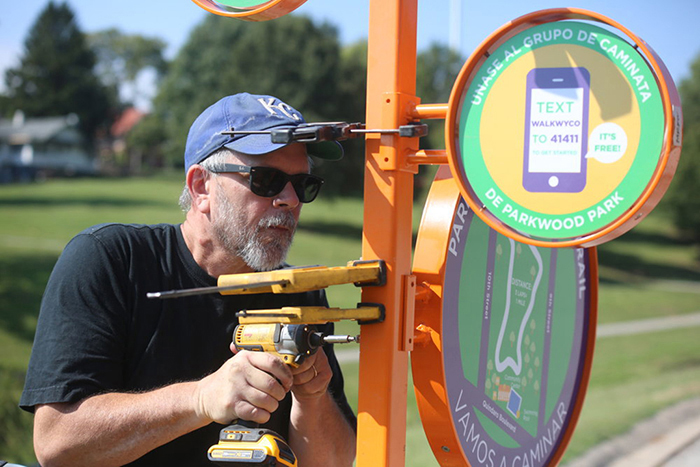‘Active living trails’ give boost to public parks

LAWRENCE — For not much money, you can change the public's perception of a park in a neglected part of town, thereby stimulating healthful activity and perhaps even economic benefits to the surrounding neighborhood.
Those were the results of a study conducted this summer by the Dotte Agency, a project of Shannon Criss, associate professor of architecture, and doctoral student Matt Kleinmann. The Dotte Agency was one of three groups across the nation to receive grants from the new Gehl Institute to try out its cutting-edge tools for measuring activity and value in public space.
An offshoot of renowned, Copenhagen-based Gehl, the firm behind the pedestrianization of Times Square, among other bike- and ped-friendly projects worldwide, the Gehl Institute was established in 2015 with the aim of boosting urban livability by reforming public space and increasing public engagement and economic opportunity.
That’s been the Dotte Agency’s purpose since it was established in 2013 in Wyandotte County/Kansas City, Kansas. It consists of a downtown storefront and the time, funding and student support Criss, Kleinmann and Architecture Professor Nils Gore can muster on behalf of and in cooperation with neighborhood groups. Kleinmann’s doctorate focuses on public health, so that was the tack he took when he applied for and won Gehl Institute’s first Open Call: Proposals for Public Life Competition, along with the venerable Neighborhood Design Center in Baltimore and a consortium of Latent Design and Archeworks in Chicago.
With $5,000 from Gehl Institute, $6,000 already raised by neighborhood groups and support from the Health Care Foundation of Greater Kansas City — plus important input from park users — a series of informational, inspirational, bilingual signs were installed in two parks in northeast Kansas City, Kansas: Parkwood and Heathwood. Some of the money went to the YouthBuild KCK organization to create and install substantial and colorful improvements: benches and see-saws.
Using a modified version of the Gehl Institute tool kit, neighbors were observed and surveyed both before and after the intervention, and they liked what they saw.
Criss said the taller, circular trail signs had been designed as part of a previous, student-led project, and they were installed in August during the grant period.
“We wanted to see if sign elements in parks made a difference,” Kleinmann said. “Do people notice? Do they say they are more likely to use a park for physical activity than before? You assume that when you change the built environment, people’s perception is changed. If you see a place to work out, to jog safely, you are more likely to do that.
“So it’s not build it and they will come, but build it and it might change perceptions. We wanted to test that through this project.”
The Dotte Agency, partners and volunteers installed 20 signs — 10 in each park — referencing facts like how walking reduces the risk of diabetes. They organized a trash cleanup. They took down a bullet-riddled “no parking” sign that virtually screamed “not welcome!”
The idea behind these “active living trails” was to introduce health education, motivation and social connectedness on a very modest budget, Criss and Kleinmann said.
“If you restore your parks, you are basically restoring an anchor to the neighborhood,” Kleinmann said.
And while the random surveys were not scientifically rigorous, they were enough for Kleinmann to cite as “evidence that what we are trying to do has impact.
“After our intervention, you see the number of people that said that they would use the park went up by quite a bit,” he said. “The next question was, ‘How do you feel about the park after you see more signage?’ and people reported liking the park more than before. People said they felt safer.”
“Our partners are very positive. That’s more meaningful for me,” Criss said. “It was a big return on the investment of time and money. We gained the confidence of county commissioners, the Parks & Rec and other neighborhood leaders.”
“We’re building capacity in the neighborhood,” Kleinmann said. “It’s a way of trying to be inclusive and also to measure whether what Dotte Agency is doing is actually making a difference. We’ve always assumed yes, but it’s nice to actually get evidence back.”
Photo: Architecture Professor Nils Gore installs an inspirational sign in KCK's Parkwood Park. Credit: Matt Kleinmann